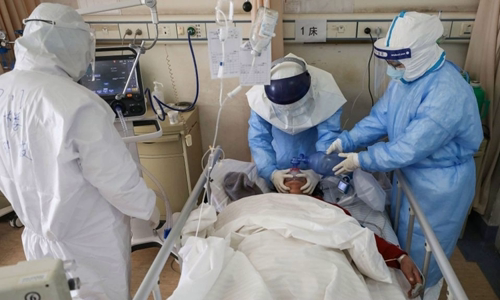Hubei reported the good news on February 20 that there were only 349 more cases of nCoV, but behind the sharp decline was the change in Chinese practices.
Within a week, China changed the way statistics of nCoV cases were twice. On February 13, Hubei announced the inclusion of both clinically diagnosed viral infections (diagnosis based on symptoms consistent with Covid-19 and CT scans) into the new case data. This change makes the number of new cases reported in the province on February 13 nearly 10 times higher than the previous day.

Medical staff take care of patients in Wuhan on February 16 Photo: Reuters
China explained this change is because it has improved its capacity to test nCoV. Wang Guqiang, director of the Association of Infectious Diseases of the Chinese Medical Association, said: "In order to resolve the inconsistency between diagnosis and treatment, Hubei initially set up clinical diagnostic criteria to treat. promptly treat patients who are more likely to be infected with nCoV and reduce mortality ".
"But now the situation in Hubei has changed. The ability of nucleic acid testing has improved greatly. Now all suspected or unconfirmed cases can be tested for nucleic acid quickly." Nucleic acid testing is no longer a problem. "
However, scientists have shown that nucleic acid testing can give false-negative results, leaving the patient behind. It is reported that in many parts of China, there is a lack of testing equipment and inaccurate results are leading to delays in patient diagnosis and treatment.
The World Health Organization has previously voiced support for the way China counts nCoV infections. On February 20, they expressed their excitement about the decline in new cases. However, some experts, including the former U.S. Food and Drug Administration member, are skeptical because China has been hiding information about this and previous outbreaks.
Jonathan Read, an epidemiologist at Lancaster University in the UK, says the definition of "case" sometimes needs to be revised. But statistics with inconsistent methods make it difficult for scholars to imagine the overall picture of disease trends.
"The change too often does not help the purpose of monitoring the situation," Read said.
Eric Feigl-Dinh, scientist at T.H. School of Public Health Chan of Harvard University, says changing twice within a week is "very unusual". "It's really hard to identify the real trend. They make things complicated," he said. "Has the number of cases actually decreased, or is it just because they have excluded the data?".
Experts also question the reliability of relying only on laboratory tests. "There is evidence that someone initially showed a negative result for nCoV and was only positive later," Feigl-Ding said.
The fact that China does not recognize patients who are positive for nCoV but has no symptoms also raises questions among experts. This approach is different from countries around the world, Feigl-Ding said.
For example, 11 Americans who flew from Japan to the US last week were positive for nCoV but had no symptoms. These people are counted as confirmed cases in the US, but not if they are in China.
"It's tiring," Feigl-Ding said. Trying to count global cases with such a difference is like "mixing apples and oranges and counting." He called on China to show the number of asymptomatic but positive patients with nCoV "for international comparison".
The Centers for Disease Control and Prevention says that asymptomatic patients can still spread the virus.
In addition to the official source, scientists around the world are looking to other sources and offering research based on that data. Caitlin Rivers, a scholar at the Johns Hopkins Health Security Center, says these sources are useful for professionals, but warns that they can be confusing for non-professionals because they don't know how to act. solution.
Knowing the severity of the disease is critical to localizing people at high risk of infection and death. John Allen Paulos, a professor of mathematics at Temple University, said there are still "layers of mist" around the Covid-19 data.
These numbers "are vague and unclear," he said. "We do not fully understand the situation and at this time, every possible precaution should be taken."



 CandyMason
CandyMason







